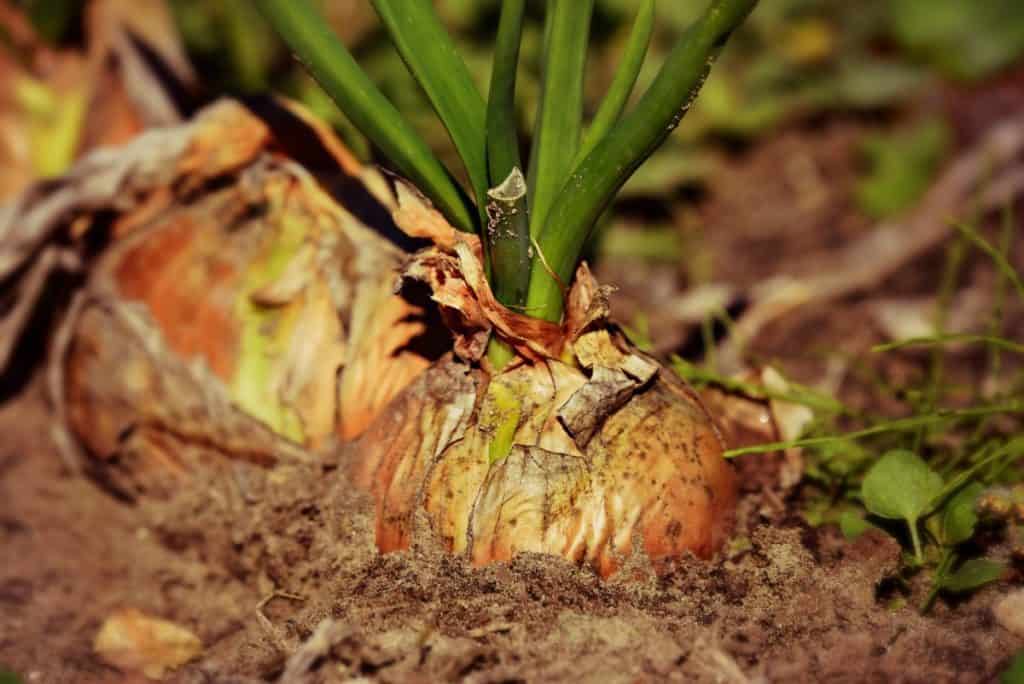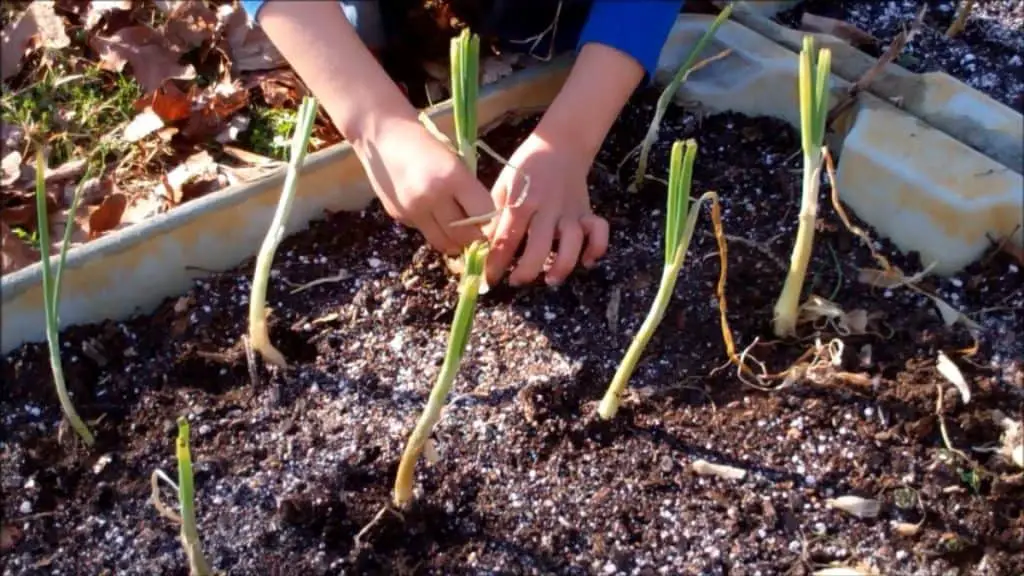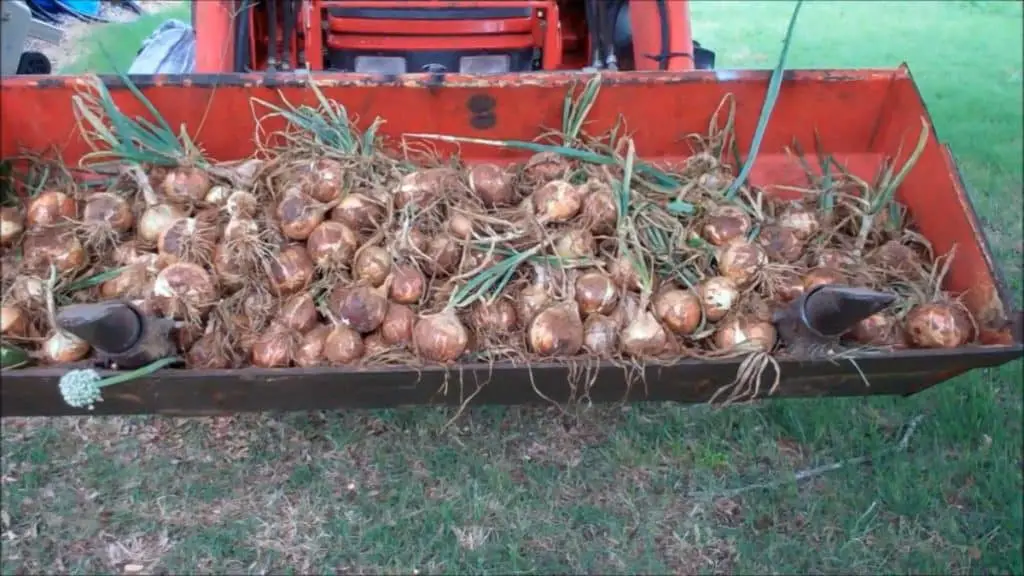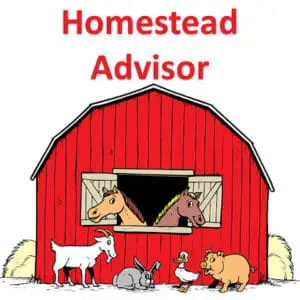Onions will grow just about anywhere, but to get those big softball-sized onions that we all want, there are a few things to consider. Let me show you how to make ‘em Big and Sweet! Isn’t that what everybody wants?
Just about everybody loves onions, and most people want them to be sweet and as large as possible. Let me show you how to raise the biggest and sweetest onions you’ve ever eaten. It’s not difficult at all, but there are a few important keys to growing really nice big onions.

Planting Time
The first important key is when to get them in the ground. Planting time is subjective, in that it depends on where you are. In the south, the best planting time is late November through December. In other parts of the country, obviously it will be different. The main factor is, to get the greatest amount of growing time possible for that onion in the window of opportunity that your climate affords.
There are 3 varieties for you to consider. the short-day variety, the intermediate-day, and the long-day variety. Here in the Deep South, most people plant the short-day variety. It does the best around here and makes some really nice onions. If you are above the Mason-Dixon Line you will probably need to plant long-day onions. And if you are a few hundred miles either side of that line, you should consider the intermediate-day onion.
In the south, we typically buy what is called an onion “set”. It is basically a very small onion. They will vary in size, and they come in a “bunch”. Some will be much smaller than a pencil, others will be larger. They typically come in bunches of around 50 and are wrapped with a rubber band.
I’m located in an area that has many many onion growers. I don’t know of any serious onion grower that raises their own onions from seed. Up north, it may be more common to raise onions from seed, but not in the south. That’s because we have access to some really nice onion sets. It may be that you Northern folks haven’t heard about buying your onions in these “sets”.

Buying onion sets takes a lot of the guesswork out of onion growing. To have someone else start your onions from seed takes a lot of the effort out of the onion growing process. Instead of hoping your onion seeds germinate, and babying your little onion plants till they develop into plantable entities, it’s so much easier to leave that stage of growth to someone else. These onion “sets” usually sell for 2 or 3 dollars per bunch. I’ll tell you some great places to buy your onion sets a little later.
As I mentioned, onion growing is a big thing around here. The Noonday Onion Growers Association (which is near me) has dozens of members growing thousands and thousands of onions. They even have a festival every year in June, when it’s time to pull the onions in our area. Also, you’ve probably heard of Vidalia Onions.
They are supposed to be some of the sweetest in the world (but the Noonday folks would disagree). Most of those hardcore Onion Growers plant in November or December. But, there have been winters in which the onions that they planted were killed by very cold weather in January and February. It doesn’t happen often around here, but it does happen.
That’s why in the northern areas where you have severe winters you would need to check with your local Agriculture Extension Agent as to when to plant. Most of my research says to plant in northern areas just before the last frost.
Onion Growth
Obviously time is one of the greatest factors in getting your onions to grow large. that’s why it’s important that you get them in the ground as soon as you can and still be safe from a hard freeze. Frost in my experience, won’t hurt an onion but a hard, hard freeze with temperatures in the single digits, with ice and snow, can hurt or even destroy them. I’ve seen it happen, and I’ve had to replant my onions as a result.
You do want to get as much “vegetative” growth as you possibly can. By vegetative growth, I mean the green tops of the plants. The leaves. Each leaf represents a layer of that onion. So, it stands to reason that the more leaves on top you have, the more rings you’ll have on that onion, and the larger the onion should be. So, plant your onions as early as you possibly can, and you should see a nice-sized prize waiting for you in a few months.
How To Plant
I’ve had many conversations with onion Growers around here. They tell me that to get the optimum size on that onion, it needs to be planted shallow. Most people I see planting onions on YouTube plant them much deeper than I do, and deeper than I have been told to do by onion growing professionals. They tell me to just put the bulb in the ground a very short distance.
Typically, I will put the roots of the onion set in the ground and maybe a half of an inch of the bulb. I don’t plant the onion so deep that the any of the green leaves are in the ground. now, that may be an old wives tale as to how deep to plant, but it has worked for me and I have grown many, many big, and very sweet onions as a result of this planting method.
The theory is that if the onion is planted deep, especially if your soil is hard, the compaction around the onion won’t allow it to expand and grow large. So they plant their onion shallow, and so do I. In fact, when the onion is mature and just about ready to be pulled, most of the onion is above ground. The roots and a small portion of the bottom of the bulb is the only thing in contact with the ground.

Punch a shallow hole with your finger and set the onion in the hole. Then, pull some soil to it and pinch the soil around the onion. Make sure the bottom of the onion (the bulb) has good contact with the ground and the roots are sealed off by pinching the soil onto the little onion.
If you have high winds in your area you might want to plant your onions a little deeper. Plant them deep enough where the wind won’t blow them over. There are times when I have to come back and pick some of my onions up and replant them because they’ve been knocked over by a windstorm or rainstorm. But, that’s due to me planting them very shallow. I go by the old saying used when planting a fruit tree: “Plant it high it won’t die. Plant it low it won’t grow”.
Also, onions need to be planted pretty close. Plant your onions about four inches apart, or six inches at most. Even at four inches apart, it looks like the distance between each onion is a lot but remember the plan… They are going to get really big. As they grow, they will fill in the distance between each other pretty quick.
Another reason for planning them close is that you’re not going to be able to wait till they get large to pull some. You’ll want to go out and pick “green onions” (which are just undersized onions). They look kind of like a shallot. It’s before they really start to grow big bulbs and they are really good to eat at that stage. Even the green tops! So when you thin them out to eat, thin out every other onion. That will leave room for the other onions to grow really big.
Fertilization
Onions are heavy feeders. They need a lot of fertilization, and they need a lot of water. So pre-fertilization is important. I confess, I don’t always pre-fertilize, but they really do need it, And will reward you for providing it. When onions are young they need a balanced fertilizer. something with a lot of phosphorus and potassium in it.
As they grow larger, they need a little more nitrogen. But be careful. In my experience and the experience of all the onion growers I know, nitrogen can also make them hot. Now some people like hot onions and for them this would be fine. But I like sweet onions so I don’t use a ton of nitrogen.
Compost might be the best fertilizer for onions. The best onions I’ve ever grown we’re simply top-dressed with compost. Just straight out of the bag compost. I planted the onions, then covered tops of the onions with about an inch of compost. They got huge and they were as sweet as an apple.
Where To Buy Onion Sets
Around here, you can find onion sets just about everywhere in the late fall and early winter. That’s when planting around here begins. Most stores that sell feed and such things to farmers, or sell seedling plants in the springtime, will also have onion sets at the proper time.
I usually buy my onions at the local feed store. I have also seen them at the big box stores like Lowe’s or Home Depot. Most of these probably come from Bonnie Plants or Dixondale Farms. They are huge growers of onions sets, and they have a large variety of onions for just about any taste and any locality. They do sell the short-day, long-day, and intermediate-day onions.
As I said before, around here, farmers take onion growing very serious. Most of the growers plant a 1015 onion. It was developed by Texas A&M and it is a super sweet onion that can get very large. It comes in yellow and white varieties. I like the yellow. I think it stores longer than the white, but that may just be my imagination.
The Harvest
Most onions take about a hundred days to mature. The 1015 onions are mature in about 110 days in the south. They only take about 75 days in the northern climate. Since we plant in late fall or early winter here in the South, they are ready in May and June. Most people in my area pull on around the 1st week of June.
When you see the tops of the onions (the green part) begin to fall over, they are mature and ready to be pulled. You don’t have to pull them right then. They can stay in the ground longer if you wish, but they have probably done all the growing they’re going to do. They are as big as they are going to get. Then, just pull them up by their green stalks.
There should be no need to dig them like potatoes, they should come right up when pulled (especially if you planted them shallow). Sometimes the leaves will break off leaving the onion in the ground. If that happens, just dig under the onion with a garden trowel and pull it up.

Storage
Onions need to be dry before they are stored. I always just lay mine out either on a concrete floor or on top of a wire basket or shelf that allows air to circulate underneath them. I turn the fan on and let it blow across the onions. This will dry out the tops as well as the onion.
When the onion leaves (the green parts) are dry then the onion is probably dry enough to store. Around here most people just lay them out in a garage or even on the ground and let them dry out naturally. Personally, I like to turn a fan on them to make sure they’re getting plenty of airflow across the onions for a couple of weeks. When they are dry, they will store for several months.
It’s best to store them in a cool dark place where they are not touching each other. Some people will string them up by their leaves and hang them up. Again, if you string them up like this, you don’t want the onion bulbs to touch each other. That could cause them to rot prematurely.
I hope you will consider planting onions in your garden. They are an easy vegetable to grow, they don’t take up much space in the garden, and they are so versatile in the kitchen. Not only do we enjoy cooking with them, but also eating them raw with just about any savory meal. There are few vegetables that add as much flavor to dishes as the lowly onion. If you’ve never grown them you should give it a try.
Here’s a video showing the planting method I discuss here; Watch!
I have around 800 videos on my YouTube Channel dealing with Growing Onions, Homesteading, Gardening, raising Livestock and Emergency Preparedness. You can find it HERE


